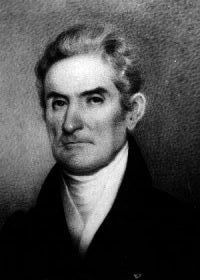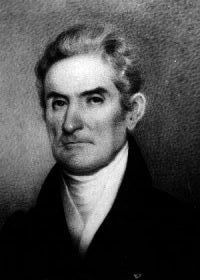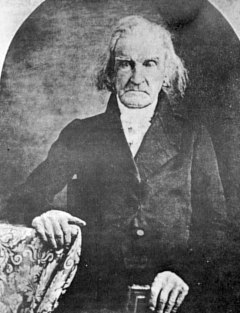"Nathaniel Heyward, wealthy rice planter, was born 18 January 1766, the son of Daniel Heyward and Jane Elizabeth Gignilliat. Although only a young boy, he served as a powder monkey in the Charleston Battalion of Artillery during the American Revolution. Upon coming of age, he traveled abroad for a year and then returned to South Carolina. Having inherited several small tracts from his father, he eventually became one of the largest and most successful planters of his time. Through purchases and grants he obtained some 25,000 acres in Charleston, Beaufort, and Colleton districts. He resided at The Bluff plantation (422 acres) on the Combahee River and owned a town house at 118 East Bay in Charleston. In 1805, Heyward bought from his brother-in-law Gabriel Manigault Silk Hope (3,500 acres), Pompion Hill (991 acres), and Club House (336 acres) plantations on the Cooper River. Before his death he accumulated at least nineteen other plantations and assorted lands throughout the low country. An inventory of his estate, valued at $968,441, recorded 1,691 slaves and the following plantations: Marshland Farm and Ashley Farm on Charleston Neck; Blanford, Clay Hall, and Williams Island in Beaufort District; Savannah, Amsterdam, Rotterdam, Lewisburg, Middlehouse, Rose Hill, Pleasant Hill, Pines, Hamburg, Copenhagen (including Antwerp), and The Bluff in Colleton District.
"Public service began for Heyward when he represented St. Peter Parish in the Eighth General Assembly (1789 - 1790). He also served that parish as a delegate at the state constitutional convention (1790). St. Thomas and St. Denis Parish elected him to the Seventeenth (1806 - 1808) and Eighteenth (1808 - 1809) General Assemblies. Heyward served as vice president and president of the South Carolina Association, an organization formed in 1823 to combat slave insurrections and enforce race control. In November 1832 he signed the Ordinance of Nullification which voided the federal tariff acts of 1828 and 1832. Other positions he held included member and vice president (1799 - 1800) of the Agricultural Society, militia captain (ca. 1810), and trustee of the Medical College of South Carolina (ca. 1832 - 1836).
"On 27 February 1788, Heyward married Harriet (Henrietta) Manigault, daughter of Peter Manigault and Elizabeth Wragg. Nine children were born to them....Harriet Manigault Heyward predeceased her husband 28 June 1827. Survived by four children, Nathaniel Heyward died 10 April 1851 at The Bluff and was buried on the grounds."
"Nathaniel Heyward, wealthy rice planter, was born 18 January 1766, the son of Daniel Heyward and Jane Elizabeth Gignilliat. Although only a young boy, he served as a powder monkey in the Charleston Battalion of Artillery during the American Revolution. Upon coming of age, he traveled abroad for a year and then returned to South Carolina. Having inherited several small tracts from his father, he eventually became one of the largest and most successful planters of his time. Through purchases and grants he obtained some 25,000 acres in Charleston, Beaufort, and Colleton districts. He resided at The Bluff plantation (422 acres) on the Combahee River and owned a town house at 118 East Bay in Charleston. In 1805, Heyward bought from his brother-in-law Gabriel Manigault Silk Hope (3,500 acres), Pompion Hill (991 acres), and Club House (336 acres) plantations on the Cooper River. Before his death he accumulated at least nineteen other plantations and assorted lands throughout the low country. An inventory of his estate, valued at $968,441, recorded 1,691 slaves and the following plantations: Marshland Farm and Ashley Farm on Charleston Neck; Blanford, Clay Hall, and Williams Island in Beaufort District; Savannah, Amsterdam, Rotterdam, Lewisburg, Middlehouse, Rose Hill, Pleasant Hill, Pines, Hamburg, Copenhagen (including Antwerp), and The Bluff in Colleton District.
"Public service began for Heyward when he represented St. Peter Parish in the Eighth General Assembly (1789 - 1790). He also served that parish as a delegate at the state constitutional convention (1790). St. Thomas and St. Denis Parish elected him to the Seventeenth (1806 - 1808) and Eighteenth (1808 - 1809) General Assemblies. Heyward served as vice president and president of the South Carolina Association, an organization formed in 1823 to combat slave insurrections and enforce race control. In November 1832 he signed the Ordinance of Nullification which voided the federal tariff acts of 1828 and 1832. Other positions he held included member and vice president (1799 - 1800) of the Agricultural Society, militia captain (ca. 1810), and trustee of the Medical College of South Carolina (ca. 1832 - 1836).
"On 27 February 1788, Heyward married Harriet (Henrietta) Manigault, daughter of Peter Manigault and Elizabeth Wragg. Nine children were born to them....Harriet Manigault Heyward predeceased her husband 28 June 1827. Survived by four children, Nathaniel Heyward died 10 April 1851 at The Bluff and was buried on the grounds."
Inscription
NATHANIEL HEYWARD
who departed this life April 10, 1851
Aged Eight Five years
Family Members
Advertisement
Records on Ancestry
Sponsored by Ancestry
Advertisement

















